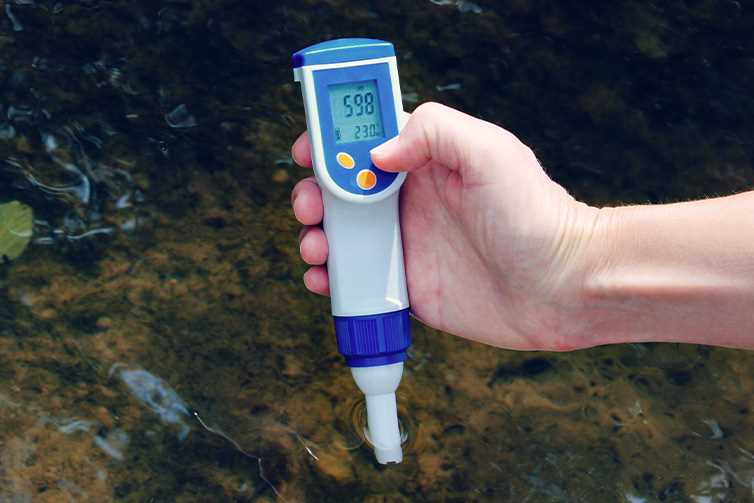EnviroMail 42 Canada
Techniques for Accurate Measurement and Estimation of Total Dissolved Solids
Total Dissolved Solids (TDS) is defined as the residual mass of dissolved inorganic and organic substances in water that passes through a standard glass fibre filter paper, after evaporation at 180°C.

Overview of Total Dissolved Solids
The principal components of TDS are usually the major cations – sodium, potassium, calcium, and magnesium, and the major anions – chloride, sulfate, and alkalinity (primarily bicarbonate), but many minor components can be significant contributors in some samples. Routine measurement of TDS is important for controlling water and wastewater treatment systems, and for establishing compliance with regulatory criteria or objectives. High levels of TDS can contribute to scale buildup in pipes and boilers and can reduce the efficiency of water filtration systems.
Health Canada and the US EPA have both established aesthetic objectives for TDS in drinking water at 500 mg/L, due to taste, palatability, and corrosive effects on water distribution systems. Many Canadian provinces have established TDS standards at this level for water uses related to drinking water (e.g., BC, AB, SK, ON).
Alberta has issued two important Directives that rely on TDS to characterize “saline water”, defined in the Alberta Water Act (Reg. 205/1998) as water with TDS exceeding 4,000 mg/L. These are Directive 65 (Resource Applications for Oil and Gas Reservoirs), and the Water Wells and Ground Source Heat Exchange Systems Directive.
TDS is an empirical parameter – which means it is defined by the test method used to measure it – and there is broad international agreement that the primary reference method for TDS is the gravimetric method (TDS-Grav). Because of this, TDS in unknown samples can only be measured accurately and definitively by the gravimetric method (APHA 2540C1), although good estimates of TDS can often be derived by summation of its major components, or by calculation from conductivity. Alberta, BC, and Ontario have each specified requirements for use of the gravimetric method for regulatory TDS evaluations — Alberta through Groundwater Information Letter 1/20103,4, BC through the BC Environmental Laboratory Manual, and Ontario through Safe Drinking Water Act analytical protocols. The CCME analytical methods guidance manual5 also recommends the gravimetric TDS method for regulatory purposes, and has been adopted by several provinces that don't issue their own laboratory method requirements (e.g., AB, MB, SK).
Accurate Measurement of TDS by Gravimetry
The gravimetric TDS method is one of the simplest tests offered by environmental laboratories. TDS is measured using a sensitive analytical balance to weigh residual dissolved solids from a water sample after filtration, evaporation, and heating at 180°C. For TDS, whether a substance is considered “dissolved” is operationally defined by whether it passes through a standard glass fibre filter (pore size ~ 1-2 µm). The consequence of this characteristic of the method is that dissolved solids include ionic, molecular, and colloidal substances, as well as some fine clay particles. Extensive heating at 180°C evaporates and drives off physically trapped water and the water of crystallization of hydrated salts, and converts bicarbonate alkalinity to carbonate salts, with corresponding loss of CO2 gas based on equation 1:
| 2 ∙ HCO3- → CO32- + CO2(g) + H2O(g) |
Estimating TDS by Summation of Major Ions
TDS can be estimated with reasonable accuracy by the summation of major ion concentrations. This approach is based on APHA 1030E, Checking Analyses’ Correctness2. APHA 1030E is not considered a test method, and TDS-Calc cannot be accredited. In the APHA 1030E reference, TDS-Calc is intended for verification of analytical data quality, e.g., by comparison of TDS-Calc to TDS-Grav or conductivity (similar to how Ion Balance is used – refer to EnviroMail 36).
Several cautionary factors must be considered when using TDS-Calc as an estimate of TDS. For most samples, summation of only the major ions (as shown in Table 1 for EC103.APHA) is sufficient for a satisfactory estimate of TDS, where TDS-Grav is considered the reference. But for complex samples, less common ions can be significant contributors to TDS, and the estimate will be biased low if these are omitted. The standard ALS Canada test code for TDS-Calc is EC103, which includes several important minor ions (as shown in Table 1), as well as DOC, where results are available. DOC can contribute significantly to TDS, especially due to humic and fulvic acids, which can comprise up to 80% of the DOC of natural waters. Another potential bias with TDS-Calc is that test results for dissolved metals use filtration through 0.45 µm filters, which differs from the 1–2 µm filters used for TDS-Grav. APHA recommends inclusion of silicate for TDS-Calc, but this can cause double-counting, since silicate is at least partially captured by the alkalinity titration (silicate is normally estimated as dissolved silicon x 2.71, to convert to the molecular weight of SiO32-). The standard TDS calculation models in Table 1 are suitable for a pH range of 5–9, which is typical for most natural waters, where the concentrations of hydroxyl and hydrogen ions are insignificant.
Importantly, a factor of 0.600 is applied to total alkalinity (mg/L as CaCO3) for inclusion in TDS-Calc, to account for the molecular weight ratio of CO3 / CaCO3, because only the carbonate portion of alkalinity is included with TDS. When calculating TDS from a bicarbonate anion concentration (mg/L as HCO3-), the conversion factor is 0.492 (the molecular weight ratio of CO32- / 2 x HCO3-), which accounts for partial conversion of bicarbonate to CO2 gas during evaporation, as per equation 1.

Table 1. TDS-Calc Summation Components
Estimating TDS from Conductivity
Approximations of TDS can also be derived directly from electrical conductivity (EC) measurements. In fact, outside of analytical laboratories, this simple technique is probably the most commonly used approach to TDS measurement, which is highly valuable for quick estimates and for real-time monitoring of water treatment systems and industrial processes. APHA 1030E states that for potable waters, the expected range for TDS/EC is from 0.55–0.70 (with TDS as mg/L, and electrical conductivity as µS/cm). ALS offers approximate TDS-Calc estimates from conductivity, calculated as EC x 0.65, using test code EC103A.
For complex waters, the TDS/EC ratio can vary significantly from the normal range. In a study of > 4,500 samples, ALS compared conductivity values with TDS-Grav measurements; from this study, we estimate that the 95% confidence interval for uncertainty of TDS-Calc from conductivity is approximately +/- 45% (for TDS > 100 mg/L). In contrast, typical measurement uncertainty for TDS-Grav (for TDS > 100 mg/L) is approximately +/- 15% (decreasing at higher levels). TDS-Calc from conductivity is most valuable and accurate for sample types that are well-characterized and consistent, where TDS-Grav results are used to derive a sample-specific TDS/EC factor; otherwise, accuracy is limited, partly because the equivalent ionic conductance of different ions varies.

Figure 2. Estimating TDS by Conductivity
Sampling Details and Test Codes
The most common ALS Canada test codes for TDS-Grav and TDS-Calc are shown in Table 2 with Limits of Reporting (LORs) and sample container details. As part of our sample miniaturization initiative, ALS Canada has reduced the sample size required for TDS and most other general water chemistry tests by half, to 250 mL. There is no preservation for the TDS-Grav method, and the hold time is 7 days. ALS recommends the gravimetric TDS method for all regulatory applications, in accordance with applicable provincial and federal requirements. All ALS Canada labs that offer the TDS-Grav test hold ISO 17025 accreditation through CALA. Reported TDS-Calc values are considered to be estimates, not formal lab tests, and are not accredited.

Table 2. ALS Canada TDS Test Codes
Please contact your ALS Canada Project Manager for more information or to arrange for sample containers.
References:
- APHA Standard Methods 2540C, Total Dissolved Solids Dried at 180°C, Standard Methods for the Examination of Wastewater, APHA/AWWA/WEF, June 2020.
- APHA Standard Methods 1030E, Checking Analyses’ Correctness, Standard Methods for the Examination of Wastewater, APHA/AWWA/WEF, July 2021.
- Clarification of the Method Used to Determine Total Dissolved Solids for Regulatory Purposes in Alberta, Groundwater Information Letter 1/2010, Alberta Environment and Water, 2010.
- Determining the Salinity of Groundwater for Regulatory Purposes in Alberta, Brent Welsh, Alberta Environment and Water Operations, Watertech 2012, https://www.esaa.org/wp-content/uploads/2015/01/WaterTech2012-P13.pdf
- Guidance Manual for Environmental Site Characterization in Support of Environmental and Human Health Risk Assessment, Volume 4, Analytical Methods, Canadian Council of Ministers of the Environment (CCME), 2016.





















































